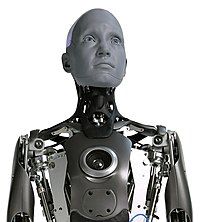
Photo from wikipedia
Purpose The purpose of this study is to understand the perceptual differences toward smiling behaviors with head inclinations displaying by the human-like robot staff and human staff in a service… Click to show full abstract
Purpose The purpose of this study is to understand the perceptual differences toward smiling behaviors with head inclinations displaying by the human-like robot staff and human staff in a service setting. Design/methodology/approach This study adopted a 2 (staff: robot/human personal personnel) × 3 (head tilt: left/right/straight) full factorial design, while cross-examining participants’ cultural dimensions 2 (power distance: high/lower) × 2 (gender: male/female) during the service encounter. Findings Overall, it was found that male and female customers with different cultural background would perceive robot and human personnel with varying degrees of head tilt very differently, namely, regarding interpersonal warmth but not customer satisfaction. Originality/value Nonverbal cues serve as important elements in the interaction. This paper provides new directions on the design of anthropomorphic robot and gives insight to people’s perceptual differences. All in all, the present study is useful in facilitating human–robot interactions.
Journal Title: Tourism Review
Year Published: 2019
Link to full text (if available)
Share on Social Media: Sign Up to like & get
recommendations!